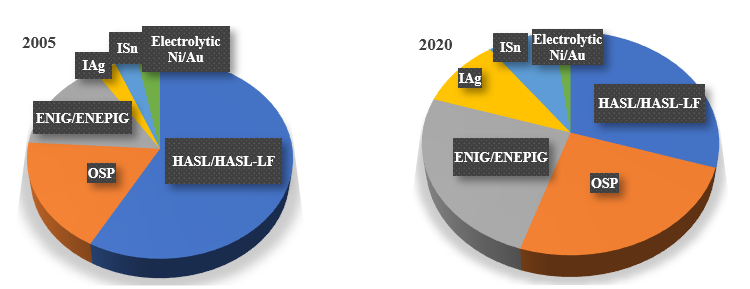How to Choose Surface Finish for Your PCB Design
Ⅲ The selection guidance and developing trends

As the above chart shows, PCB surface finishes application have varied magnificently over the past 20 years as the technology developing and presence of environmental-friendly directions.
1) HASL Lead Free. Electronics have decreased substantially in weight and size without sacrificing performance or reliability in recent years, that has limited the use of HASL to great extent which has uneven surface and is not suitable for fine pitch, BGA, small components placement and plated through holes. Hot air leveling finish has great performance (reliability, solderability, multiple thermal cycle accommodation and long shelf life) on PCB assembly with larger pads and spacing. It’s one of the most affordable and available finish. Although HASL technology has been evolved into new generation of HASL lead-free to compliant RoHS restrictions and WEEE directives, the hot air leveling finish drops to 20-40% in PCB fabrication industry from being dominating (3/4) this area in 1980s.
2) OSP. OSP was popular due to the lowest costs and simple process and having co-planar pads. It is still welcomed because of this. The organic coating process can be used widely both on standard PCBs or advanced PCBs such as fine pitch, SMT, serve boards. Recent improvements to plate multilayer of organic coating ensure OSP stand multiple cycles of soldering. If the PCB does not have surface connection functional requirements or shelf life limitations, OSP will be the most ideal surface finish process. However its flaws, sensitivity to handling damage, short shelf life, nonconductivity and difficult to inspect slow down its step to be more robust. It is estimated that about 25%-30% of PCBs currently use an organic coating process.
3) ENIG. ENIG is the most popular finish among advanced PCBs and PCBs applied in harsh environment, for its excellent performance on planar surface, solderability and durability, resistance to tarnish. Most PCB manufacturers have electroless nickel / immersion gold lines in their circuit boards factories or workshops. Without considering cost and process control, ENIG will be the ideal alternatives of HASL and is capable of widely uses. Electroless nickel/immersion gold was growing fast in the 1990s due to solving the flatness problem of hot air leveling and the removal of organically coated flux. ENEPIG as an updated version of ENIG, solved the black pad problem of electroless nickel/ immersion gold but while is still expensive. The application of ENIG has a little slowing down since rising up of cost less replacements such as Immersion Ag, Immersion Tin and OSP. It is estimated about 15-25% of PCBs currently adoption this finish. If no bonding of budget, ENIG or ENEPIG is an ideal option on most of conditions especially to PCBs with ultra-demanding requirements of high quality insurance, complex package technologies, multiple soldering types, through-holes, wire bonding, and press fit technology, etc..
4) Immersion Silver. As a cheaper substitution of ENIG, immersion silver having properties of having very flat surface, great conductivity, moderate shelf life. If your PCB requires fine pitch / BGA SMT, small components placement, and needs to keep well-connection function while you have a lower budget, immersion silver is a preferable choice for you. IAg is widely used in communication products, automobiles, and computer peripherals, etc.. Because of unmatched electrical performance, it is welcomed in high frequency designs. The growth of immersion silver is slow (but still rising up) due to downsides of being sensible to tarnish and having solder joint voids. There is about 10%-15% of PCBs currently use this finish.
5) Immersion Tin. Immersion Tin has been introduced into the surface finish process for over 20 years. Production automation is the main driver of ISn surface finish. It is another cost-effective option for flat surface requirements, fine pitch components placement and press-fit. ISn is especially suitable for communication backplanes for no any new elements added during the process. Tin Whisker and short operate window is the major limitation of its application. Multiple type of assembling is not recommended given intermetallic layer increase during soldering. In addition, the use of tin immersion process is restricted due to the presence of carcinogens. It is estimated that about 5%-10% of PCBs currently use the immersion tin process.
6) Electrolytic Ni/Au. Electrolytic Ni/Au is the originator of PCB surface treatment technology. It has appeared with the emergency of Printed circuit boards. However, the very high cost magnificently limits its application. Nowadays, Soft gold is mainly used for gold wire in chip packaging; Hard gold is mainly used for electrical interconnection in non-soldering places such as gold fingers and IC carriers. The proportion of Electroplating Nickel-gold is approximately 2-5%.
Back to Blogs
Post time: Nov-15-2022






